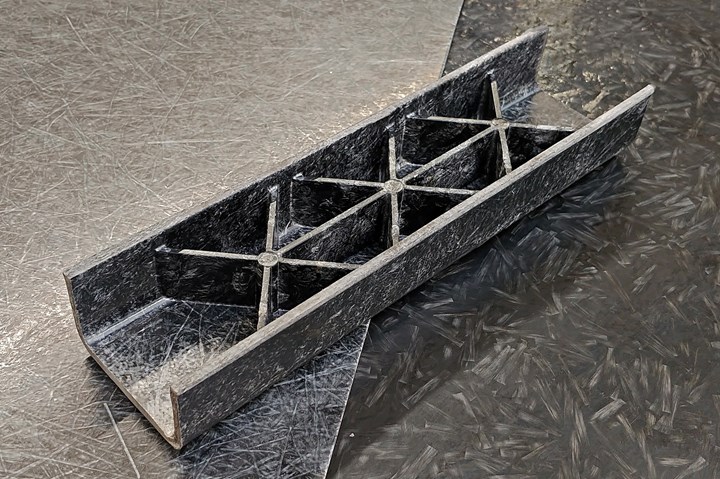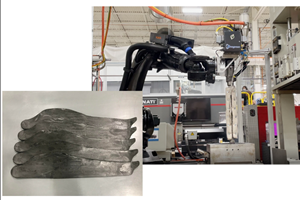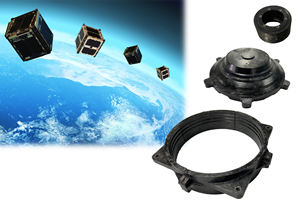Lanxess expands Tepex flowcore composite range
Focusing on lightweight components for cars, sports equipment and consumer goods, the long fiber-reinforced thermoplastic enhances ductility, recylability and processability.

No additional injection-molded material was used to produce the ribbing on the demonstrator model. It is made entirely from compression-molded Tepex flowcore. Photo Credit: Lanxess
Lanxess (Cologne, Germany) reports that it has expanded and optimized its Tepex flowcore thermoplastic composite range for compression molding. The new composites are designed as alternatives to thermoset sheet molding compounds (SMCs), offering similar mechanical performance but with enhanced ductility, recylability and processability.
“We are primarily targeting Tepex flowcore at large underbody paneling components and load compartment wells for cars, but also at components such as large casings and battery covers,” says Sabrina Anders, project manager for Tepex flowcore at Lanxess High Performance Materials (HPM) business unit. Tepex flowcore has already proven its worth in series production, says the company, such as in a bumper beam for a mid-size sedan from a Japanese car manufacturer.
The novel, plate-shaped composites are offered with a matrix based on polypropylene (PP), polyamide 6 (PA6), polyamide 12 (PA12), thermoplastic polyurethane or flame-retardant polycarbonate. The matrix is reinforced with long fibers rather than the continuous fibers found in Tepex dynalite. The fibers are up to 50 millimeters in length and are distributed throughout the matrix as cut fibers of constant lengths. Tepex flowcore is offered with either glass or carbon fiber reinforcement.
In suitable processing conditions, Lanxess claims components made from the lightweight materials can exhibit almost the same flexural stiffness as their Tepex dynalite range equivalents, and have much higher strengths than injection-molded materials, which are usually reinforced with short fibers. Depending on processing method and component design, the fibers can be arranged in one preferred direction or at complete random. “The components can be designed such that they exhibit mechanical properties quasi-isotropically; in other words, almost identically in all directions,” explains Anders.
Moreover, Tepex flowcore is said to be more versatile in terms of processability. For example, they can be compression molded with standard tools for long fiber- or glass mat-reinforced thermoplastics (LFTs and GMTs). They can also be used with existing SMC systems and tools.
“They have such good flow characteristics that delicate areas of components, such as ribbed structures, can be reproduced with great precision, and walls can be made very thin,” says Anders. Tepex flowcore and Tepex dynalite can also be used together in compression molding processes, demonstrating optimized adhesion between each other due to their identical polymer matrix. “This opens up the opportunity to use Tepex dynalite to reinforce specific component areas under particularly heavy stress and, at the same time, to integrate features such as guides and mounts in a cost-saving way with Tepex flowcore. Another benefit is that the processor obtains all these composite semi-finished products from one place rather than having to combine materials from different manufacturers.”
The new composites — much like Tepex dynalite — are also said to be well suited to the hybrid molding process. This involves forming in an injection molding tool and given features by means of injection molding in a single process. The production of the bumper support for the Japanese sedan went one step further. That structural component was made from Tepex flowcore and Tepex dynalite, overmolded and functionalized with a PA6 compound from the Durethan brand.
Related Content
Thermoset-thermoplastic joining, natural fibers enable sustainability-focused brake cover
Award-winning motorcycle brake disc cover showcases potential for KTM Technologies’ Conexus joining technology and flax fiber composites.
Read MoreJEC World 2023 highlights: Innovative prepregs, bio-resins, automation, business development
CW’s Jeff Sloan checks in with JEC innovations from Solvay, A&P, Nikkiso, Voith, Hexcel, KraussMaffei, FILL, Web Industries, Sicomin, Bakelite Synthetics, Westlake Epoxy and Reliance Industries.
Read MoreLow-void, large-scale, high-volume 3D-printed composites
Among its many composites-related projects, Oak Ridge National Laboratory recently installed its first AMCM test cell, combining extrusion with compression molding for fast, low-void, low-porosity thermoplastic composite parts.
Read MoreComposite molding compound replaces Invar for lightweight small satellite structures
Patz Materials and Technologies and Lawrence Livermore National Laboratory developed a new monolithic optics housing with 80% less weight, near-zero CTE and the high-volume manufacturing required for commercial space.
Read MoreRead Next
Tepex composite opens up new opportunities for electric skateboards
The continuous fiber-reinforced thermoplastic is used for a trough-shaped skateboard deck application, notable for its high torsional and bending strength, light weight and moisture protection.
Read MoreComposites end markets: Energy (2024)
Composites are used widely in oil/gas, wind and other renewable energy applications. Despite market challenges, growth potential and innovation for composites continue.
Read MoreFrom the CW Archives: The tale of the thermoplastic cryotank
In 2006, guest columnist Bob Hartunian related the story of his efforts two decades prior, while at McDonnell Douglas, to develop a thermoplastic composite crytank for hydrogen storage. He learned a lot of lessons.
Read More














.jpg;maxWidth=300;quality=90)











